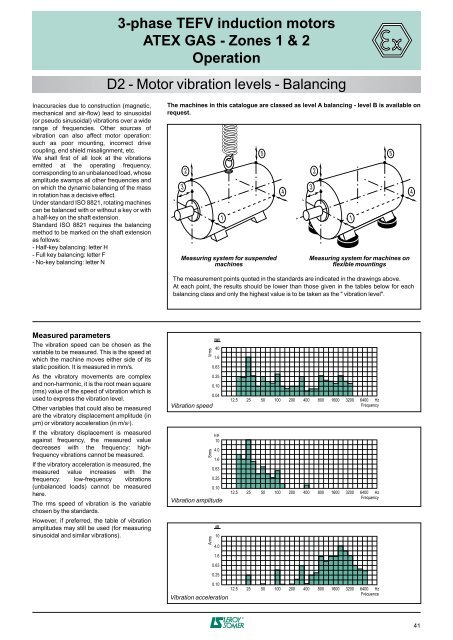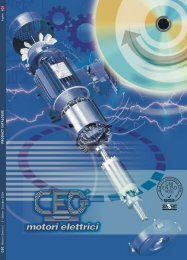3-phase TEFV induction motors ATEX GAS - Zones 1 & 2
3-phase TEFV induction motors ATEX GAS - Zones 1 & 2
3-phase TEFV induction motors ATEX GAS - Zones 1 & 2
Create successful ePaper yourself
Turn your PDF publications into a flip-book with our unique Google optimized e-Paper software.
Inaccuracies due to construction (magneti c,<br />
mechanical and air-flow) lead to sinusoidal<br />
(or pseudo sinusoidal) vibrations over a wide<br />
range of frequencies. Other sources of<br />
vibration can also affect motor operation:<br />
such as poor mounting, incorrect drive<br />
coupling, end shield misalignment, etc.<br />
We shall first of all look at the vibrations<br />
emitted at the operating frequency,<br />
corresponding to an unbalanced load, whose<br />
amplitude swamps all other frequencies and<br />
on which the dynamic balancing of the mass<br />
in rotation has a decisive effect.<br />
Under standard ISO 8821, rotating machines<br />
can be balanced with or without a key or with<br />
a half-key on the shaft extension.<br />
Standard ISO 8821 requires the balancing<br />
method to be marked on the shaft extension<br />
as follows:<br />
- Half-key balancing: letter H<br />
- Full key balancing: letter F<br />
- No-key balancing: letter N<br />
Measured parameters<br />
The vibration speed can be chosen as the<br />
variable to be measured. This is the speed at<br />
which the machine moves either side of its<br />
static position. It is measured in mm/s.<br />
As the vibratory movements are complex<br />
and non-harmonic, it is the root mean square<br />
(rms) value of the speed of vibration which is<br />
used to express the vibration level.<br />
Other variables that could also be measured<br />
are the vibratory displacement amplitude (in<br />
µm) or vibratory acceleration (in m/s2). If the vibratory displacement is measured<br />
against frequency, the measured value<br />
decreases with the frequency: highfrequency<br />
vibrations cannot be measured.<br />
If the vibratory acceleration is measured, the<br />
measured value increases with the<br />
frequency: low-frequency vibrations<br />
(unbalanced loads) cannot be measured<br />
here.<br />
The rms speed of vibration is the variable<br />
chosen by the standards.<br />
However, if preferred, the table of vibration<br />
amplitudes may still be used (for measuring<br />
sinusoidal and similar vibrations).<br />
3-<strong>phase</strong> <strong>TEFV</strong> <strong>induction</strong> <strong>motors</strong><br />
<strong>ATEX</strong> <strong>GAS</strong> - <strong>Zones</strong> 1 & 2<br />
Operation<br />
D2 - Motor vibration levels - Balancing<br />
The machines in this catalogue are classed as level A balancing - level B is available on<br />
request.<br />
3<br />
2<br />
1<br />
Measuring system for suspended<br />
machines<br />
5<br />
4<br />
3<br />
2<br />
1<br />
Measuring system for machines on<br />
flexible mountings<br />
The measurement points quoted in the standards are indicated in the drawings above.<br />
At each point, the results should be lower than those given in the tables below for each<br />
balancing class and only the highest value is to be taken as the " vibration level".<br />
Vrms<br />
Vibration speed<br />
Srms<br />
mms<br />
40<br />
1.6<br />
0.63<br />
0.25<br />
0.10<br />
0.04<br />
µµ<br />
10<br />
4.0<br />
1.6<br />
0.63<br />
0.25<br />
0.10<br />
Vibration amplitude<br />
Arms<br />
ms2<br />
10<br />
4.0<br />
1.6<br />
0.63<br />
0.25<br />
0.10<br />
Vibration acceleration<br />
12.5 25 50 100 200 400 800 1600 3200 6400 Hz<br />
Frequency<br />
12.5 25 50 100 200 400 800 1600 3200 6400 Hz<br />
Frequency<br />
12.5 25 50 100 200 400 800 1600 3200 6400 Hz<br />
Fréquence<br />
5<br />
4<br />
41



